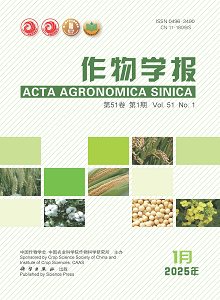棉花留茬还田和深松对滨海盐碱地棉花干物质积累、养分吸收和产量的影响
引用次数: 1
摘要
为研究棉花秸秆还田和深松对棉花产量的影响,以鲁棉研36号为试验材料,进行了盐深松耕作。结果表明,棉花留茬还田在两年内提高了棉花产量。SR的皮棉产量比CT高33.9%,SRT比SR高32.1%。2017年深松提高了棉花产量,但2018年对产量没有影响。棉花留茬还田降低了0~40cm土层的含盐量。在棉花生长后期,SR的含盐量比CT低22.4%,SRT的土壤含盐量比ST低20.7%。然而,在为期两年的试验中,深松对20–40 cm土层含盐量的影响并不明显。2017年生长后期,ST的土壤含盐量比CT低16.5%,但2018年深松对土壤含盐没有影响。棉花干物质和N、P、K的积累动态符合Logistic生长曲线。棉花留茬还田使干物质和N、P、K的最大积累量在两年内增加。SR中干物质、N、P和K的最大积累量比CT高35.5%、38.3%、53.4%和55.0%,SRT的积累量比ST高27.0%、30.7%、21.2%和42.4%。与CT相比,2017年ST的干物质、氮、磷和K积累量分别增加了17.8%、22.2%、51.3%和40.6%,但在2018年没有任何影响。干物质和养分积累动态主要受最大积累速率和快速积累持续时间的影响。在为期两年的试验中,残茬还田增加了棉花生殖器官干物质和N、P、K的分配量和比例。与CT相比,ST在2017年增加了干物质和N、P、K对生殖器官的分配量,但在2018年没有影响。综上所述,研究结果表明,棉花留茬还田(SR)或棉花留茬+深松耕作(SRT)可作为沿海盐碱棉区土壤改良和棉花高产的推荐耕作措施。本文章由计算机程序翻译,如有差异,请以英文原文为准。
Effects of cotton stubble return and subsoiling on dry matter accumulation, nutrient uptake, and yield of cotton in coastal saline-alkali soil
: To study the effects of cotton straw returning and deep loosening on cotton yield, salt subsoiling tillage (SRT) were conducted using Lumianyan 36 as experimental material. The results showed that cotton stubble return increased cotton yield across two years. Lint yield of SR was 33.9% higher than CT, and SRT 32.1% higher than SR. Subsoiling increased cotton yield in 2017 and had no effect on it in 2018. Cotton stubble return reduced the salt content of 0–40 cm soil layer. The salt content of SR was 22.4% lower than that of CT, and the soil salt content of SRT was 20.7% lower than that of ST at the late growth stage in cotton. However, the effect of subsoiling on the salt content of 20–40 cm soil layer was incon-sistent during the two-year experiment. The soil salt content of ST was 16.5% lower than of CT at late growth stage in 2017, but subsoiling had no effect on soil salt content in 2018. The accumulation dynamic of dry matter and N, P, K in cotton were consis-tent with the Logistic growth curve. Cotton stubble return increased maximal accumulation of dry matter and N, P, K in two years. The maximum accumulation of dry matter, N, P, and K in SR was 35.5%, 38.3%, 53.4%, and 55.0% higher than that in CT, and the accumulation of SRT was 27.0%, 30.7%, 21.2%, and 42.4% higher than that in ST. Compared with CT, the dry matter, N, P, and K accumulation of ST increased by 17.8%, 22.2%, 51.3%, and 40.6% in 2017, respectively, but had no effect in 2018. The dynamic of dry matter and nutrient accumulation were mainly affected by the maximum accumulation rate and rapid accumulation duration. Stubble return increased the amount and proportion of dry matter and N, P, K allocated to reproductive organs of cotton in the two-year experiment. Compared with CT, ST increased the allocation amount of dry matter and N, P, K to reproductive organs in 2017, but had no effect in 2018. In summary, the results revealed that cotton stubble return (SR) or cotton stubble return + subsoiling tillage (SRT) could be recommended tillage measures for soil improvement and high cotton yield in coastal sa-line-alkali cotton area.
求助全文
通过发布文献求助,成功后即可免费获取论文全文。
去求助
来源期刊

作物学报
Agricultural and Biological Sciences-Agronomy and Crop Science
CiteScore
1.70
自引率
0.00%
发文量
89
期刊介绍:
The major aims of AAS are to report the progresses in the disciplines of crop breeding, crop genetics, crop cultivation, crop physiology, ecology, biochemistry, germplasm resources, grain chemistry, grain storage and processing, bio-technology and biomathematics etc. mainly in China and abroad. AAS provides regular columns for Original papers, Reviews, and Research notes. The strict peer-review procedure guarantees the academic level and raises the reputation of the journal. The readership of AAS is for crop science researchers, students of agricultural colleges and universities, and persons with similar academic level.
 求助内容:
求助内容: 应助结果提醒方式:
应助结果提醒方式:


